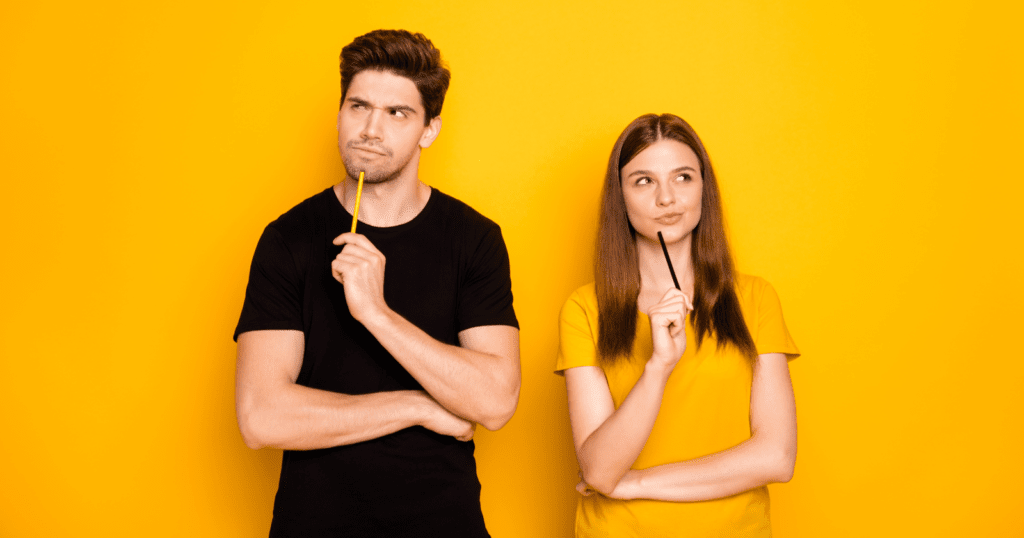According to the Content Marketing Institute’s Video & Visual Storytelling Survey, 83% of marketers say video has become more important in the last two years.
Videos were always a powerful tool in the storytelling arsenal. But maybe it’s time to re-examine our content marketing matrix.
What is a content marketing matrix and do we need one in 2022?
Well, a content marketing matrix is a planning tool to help marketers generate ideas for the most engaging content types for their audiences.
A number of them have been created over the past decade, including one that I contributed to Guy Kawasaki’s book, Enchantment: The Art of Changing Hearts, Minds, and Actions, which was published in 2011. Here’s what it looks like:
 Image by author, January 2022
Image by author, January 2022As you can see, my Content Marketing Matrix has two dimensions:
And content marketers are supposed to use the four quadrants – entertain, inspire, educate, and enlighten – “as a starting point” to review how their content can support the goals of their B2B, B2C, or not-for-profit organizations.
Do We Need A Content Marketing Matrix In 2022?
A decade later, I don’t have a problem with using a 2×2 matrix “as a starting point.”
But it reminds me of the scene in Star Trek II: The Wrath of Kahn (1982) when Captain Spock (Leonard Nimoy) analyzes the tactics of Khan Noonien Singh (Ricardo Montalbán) and observes, “He is intelligent, but not experienced. His pattern indicates two-dimensional thinking.”
That’s why I believe experienced content marketers need a three-dimensional matrix to compete successfully in a world where:
I don’t have a problem with putting “Branded Stories” (e.g., short films, series, documentaries, inspirational videos) in the upper left quadrant of the matrix above, either. I’ve seen some entertaining branded stories go viral.
I’ve also seen some inspiring, educational, and enlightening branded stories go viral, too.
And last month, we looked at how several major brands in the U.K. use nostalgic Christmas ads to build brand awareness and connect with customers on a deeper level.
Viral Marketing: The Science Of Sharing
So, maybe it’s time to share the secret of how to create branded video content that is more likely to go viral.
Actually, it isn’t a secret. It is the subject of Karen Nelson-Field’s book, Viral Marketing: The Science of Sharing, which was published in October 2013.
Back then, Dr. Nelson-Field was a Senior Research Associate at the University of South Australia’s Ehrenberg-Bass Institute for Marketing Science.
Today, she’s the founder and CEO at Amplified Intelligence.
Her book used original research from more than two years of work, five different data sets, around 1,000 videos, nine individual studies, and a large team of researchers from Ehrenberg-Bass Institute for Marketing Science.
Her research found that “an emotional response is important in driving further cognitive or behavioral responses. Reactions to advertising – or anything for that matter – are rarely purely rational.”
And the data she shared shows the most engaging content types for your audiences are branded videos that can elicit intense, positive, emotional responses, using:
If you read Dr. Nelson-Field’s book, then you’ll also learn that:
The most engaging holiday ads of 2021 indicate that Dr. Nelson-Field’s findings are still valid today.
Unruly Reveals Top Emotionally Engaging Holiday Ads Of 2021
Each year, Unruly tests holiday ads and measures them based upon emotional intensity, brand favorability, happiness, and an overall “EQ Score.”
Unruly is a global video and Connected TV (CTV) advertising platform. But, content marketers can learn some important lessons from them about how to generate ideas for the most engaging content types for their audiences.
And it’s worth noting that Dr. Nelson-Field worked with Unruly a decade ago to develop an earlier version of their methodology.
This year, Unruly analyzed the emotional responses of approximately 9,700 consumers around the world to more than 50 holiday ads using its content measurement tool, UnrulyEQ.
This tool helps advertisers maximize the impact of their video content across multiple screens, lift brand metrics more effectively, and target receptive audiences at scale.
Unruly’s annual Christmas Ad Effectiveness Chart uses their combined metric, EQ Score, to rank the most popular festive ads based on their emotional, social, and business impact.
It also benchmarks them against the average level of emotional response to advertisements in each market. And the intensity of emotions, brand favorability, authenticity, and purchase intent that viewers felt while watching an ad all contribute to its final score.
Carol Gillard, the VP of Marketing & Communications at Unruly, observed several interesting trends:
Gillard also spotted several other trends in this year’s top-rated ads:
Let’s start with “Wegmans Holiday Commercial 2021,” which was ranked #1 in the US.
The video’s description says, “The holidays are about sharing, caring, and enjoying great food. Watch as a little boy shows us that you don’t have to be all grown up to be a big helper. Let’s get back to happy, together.”
The ad from Wegmans Food Markets scored 61% in Emotional Intensity, 53% in Brand Favorability, and 38% in Happiness to get an overall EQ Score of 7.3.
Wegmans Food Markets selected Optic Sky, an advertising and digital experience production company, to produce this ad.
I asked Aaron Gordon, the CEO of Optic Sky, “What was your thinking/strategy behind the Wegmans approach to holiday advertising at this particular time in history?”
Gordon said, “This holiday spot is part of the Wegmans ‘Back to Happy’ campaign, which comprises three ads in total. It’s the first ad campaign Wegmans has run since the start of the pandemic, so it was important to consider the state of Covid-19 at the time.
On one hand, it seemed as though we were making real progress; vaccines were finally available, the economy was rebounding, and schools and stadiums were opening back up. On the other hand, we knew that Covid was unpredictable.
He added, “The Wegmans internal creative agency decided to focus all three ads on the values they as a company share with their customers, who represent all walks of life.
The Optic Sky team worked closely with Wegmans to create ads that evoke a warm, human, and nostalgic tone, while touching upon our shared yearning to leave the pandemic behind (as the campaign name, ‘Back to Happy,’ implies).
Together, we emphasized our common humanity, love of family, and hope for the future with scenes of joy, sincere caring, and family meals.”
“It’s the Most Wonderful Time of the Year | Frito-Lay” ranked #2 in the US.
The video’s description says, “Share more joy this Holi-LAY’S season with Jimmy Fallon and your Frito-Lay favorites.”
Frito-Lay’s ad scored 55% in Emotional Intensity, 45% in Brand Favorability, and 36% in Happiness to get an overall EQ Score of 7.3.
“The Whoopsery | Stories of Evergreen Hills | Created by Chick-fil-A” ranked #3 in the US.
This video’s description says, “Sam is back for another adventure this holiday season, and she brought a friend! After an unfortunate mishap, while decorating Cece’s family Christmas tree, Sam and Cece try to make it right and end up in a magical place called The Whoopsery.”
Chick-fil-A’s ad scored 56% in Emotional Intensity, 49% in Brand Favorability, and 36% in Happiness to get an overall EQ Score of 7.1.
“Macy’s Presents: Tiptoe and the Flying Machine” ranked #4 in the US.
The video’s description says, “This is the story of Tiptoe. A little reindeer with a big problem. She’s absolutely terrified of flying. So her friends get together and teach her a very important lesson: if you believe in yourself, there’s no telling how high you can soar.”
Macy’s ad scored 53% in Emotional Intensity, 48% in Brand Favorability, and 33% in Happiness to get an overall EQ Score of 6.9.
And, “OREO ‘A Holiday Twist’ :30” ranked #5 in the US.
This video’s description says, “The holidays’ favorite cookie #OREO #StayPlayful.”
And, Oreo’s ad scored 45% in Emotional Intensity, 41% in Brand Favorability, and 29% in Happiness to get an overall EQ Score of 6.7.
Unruly also tested ads in the UK. But, their methodology is different than Kantar’s, so we shouldn’t be surprised that Unruly’s results differ from the ones that I wrote about last month.
“This Christmas, Nothing’s Stopping Us l Tesco #NothingsStoppingUs” ranked #1 in the UK.
This video’s description says, “After last year, we’re determined to make it a good one. This Christmas, #NothingsStoppingUs.”
Tesco’s ad scored 36% in Emotional Intensity, 40% in Brand Favorability, and 20% in Happiness to get an overall EQ Score of 6.9.
“Spread The Merry” ranked #1 in Australia.
The description says, “The members of our letterbox choir are spreading the merry far and wide this year. Head to auspost.com.au/christmas to find out how you can #SpreadTheMerry.”
Australia Post’s ad scored 30% in Emotional Intensity, 37% in Brand Favorability, and 20% in Happiness to get an overall EQ Score of 6.5.
“THE STEPDAD | Disney Christmas Advert 2021 | Disney Channel UK” ranked #1 in the Philippines.
The video’s description says, “We are proud to reveal our Christmas advert, a heart-warming new story; #TheStepdad.
“This year’s story follows Nicole, the granddaughter from last year’s ad, who is now all grown up with a family to make Christmas traditions with. We follow her and her two adorable children, Max and Ella, as their new stepdad Mike moves into their family home.
“At the heart of the story is a very special storybook – a precious item belonging to Max from his birth father.
The book celebrates the power of storytelling and how it can deepen family bonds; as the family are shown delighting in the magic of Disney storytelling, beautiful animation springs off the pages, igniting the true spirit of Christmas.
Follow their emotional journey as we see them combine existing festive traditions with wonderful new ones. We hope you enjoy this special Christmas ad, celebrating the joy that the stepdads of the world bring us.”
Disney UK’s video scored 88% in Emotional Intensity, 86% in Brand Favorability, and 73% in Happiness to get an overall EQ Score of 6.9 in the Philippines.
“FAMILIE IST DAS SCHÖNSTE GESCHENK | DISNEY WEIHNACHTS-SPOT 2021 – lange Version | Disney HD” ranked #1 in Germany.
Disney Deutschland’s ad scored 40% in Emotional Intensity, 32% in Brand Favorability, and 23% in Happiness to get an overall EQ Score of 6.3 in Germany.
Finally, “Smile. Your special table is set” ranked #1 in Singapore.
This video’s description says, “This holiday season, connect with loved ones both near and far away over the dinner table. Dress your party table with elegant dinnerware, handmade glass, candles and twinkling fairy lights.
Exchange baskets filled with gifts and enjoy quality time with friends and family, even if they are an internet connection away.”
IKEA Singapore’s ads scored 41% in Emotional Intensity, 55% in Brand Favorability, and 23% in Happiness to get an overall EQ Score of 6.7.
“You can observe a lot by just watching”
Now, some content marketers are going to look at the top emotionally engaging holiday ads above, scratch their heads, and say, “But, those are YouTube ads!”
Yes, they are. And, according to the Content Marketing Video Survey mentioned above, re-purposed ads (long-form versions of TV ads) are one of the video types that produced the best content marketing results in the last 12 months.
And, as Yogi Berra once said, “You can observe a lot just by watching.”
Besides, a content marketing matrix is supposed to help us generate ideas for the most engaging content types for our audiences.
So, if we mistakenly think that we can’t learn lessons from the top emotionally engaging holiday ads of 2021, then we’ve got to ask ourselves: “Does this pattern indicate two-dimensional thinking?”
While we’re at it, we’ve also got to ask a couple of other related questions:
To transform this situation, we need to go beyond producing more videos in 2022. We need to make videos worth watching and create content worth sharing.
And, there are plenty of examples of branded videos that are emotionally engaging even though they aren’t ads.
If you want to see one, just watch “Google — Year In Search 2021.”
The description of Google’s branded video says, “In a year that continued to test many, the world searched “how to heal” more than ever.
Whether they’re taking care of mental health, honoring a loved one, or reuniting with family, people are finding ways to come back stronger than before.”
Uploaded on Nov. 22, 2021, it currently has 223 million views and 167,000 engagements (e.g. likes, comments, shares).
And, if you mistakenly think that B2B videos have to be rational or boring, then check out “‘Zero Tolerance Machining’ with the Wire EDM – Part 1 | US Digital #Shorts.”
US Digital designs and manufactures motion control products for OEM manufacturers as well as end users. The description of their branded video says, “Our machine shop can cut metal so precisely using our wire EDM that two parts fit together with virtually no gap between.”
Uploaded on Oct. 27, 2021, it currently has 31.1 million views and 1.4 million engagements.
We Need A Three-Dimensional Content Marketing Matrix
Looking forward, the B2B Content Marketing Benchmarks, Budgets, and Trends: Insights for 2022 report produced by the Content Marketing Institute and Marketing Profs says, “The top content marketing-related area of investment for 2022 is expected to be video (69%).
This makes sense, as businesses have shifted online, and marketers look for new/more ways to tell compelling stories to capture and keep audience attention.”
And, during a webinar on “International digital marketing strategy for 2022 and beyond,” which was held Dec. 14, 2021, Gemma Houghton, the Director of Marketing at Webcertain, shared the following stats to illustrate why this may finally be “the year of video”:
All of this is – potentially – good news. Hopefully, most content marketers won’t blow this opportunity by cranking out more branded videos that evoke moderate emotions.
Now, I realize that eliciting intense emotions sounds risky. So, let me close with an excerpt from an interview in WARC’s “Insights from the 2021 Creative Effectiveness Lions winners.”
WARC asked Ann Mukherjee, who is Chairman and CEO at Pernod Ricard North America and was President of the 2021 Creative Effectiveness Lions jury, “What stood out to you about the Grand Prix winner, Nike’s Dream Crazy?”
Mukherjee said, “We felt that Dream Crazy was the next chapter in advertising, helping the industry think about what’s possible and redefining the roles brands can play in making a positive dent in the universe.”
She added, “It’s also important to remember that Nike was actually solving a business problem around its relevance to younger consumers.
This audience does not only want to buy brands, they want to buy into brands. Nike took a risk because it understood that’s what it took. With many of the award winners this year, we wanted to send a message to the industry that they should take a risk.
A lot of these campaigns start with a business objective but go on to change lives. It’s a virtuous cycle that we wish to see more brands embracing: touching lives is what makes people come to your brand.”
That’s why we need to use a three-dimensional content marketing matrix “as a starting point” to generate ideas for the most engaging content types for our audiences. Then, we’ve also got to think outside the box.
This content was originally published here.




